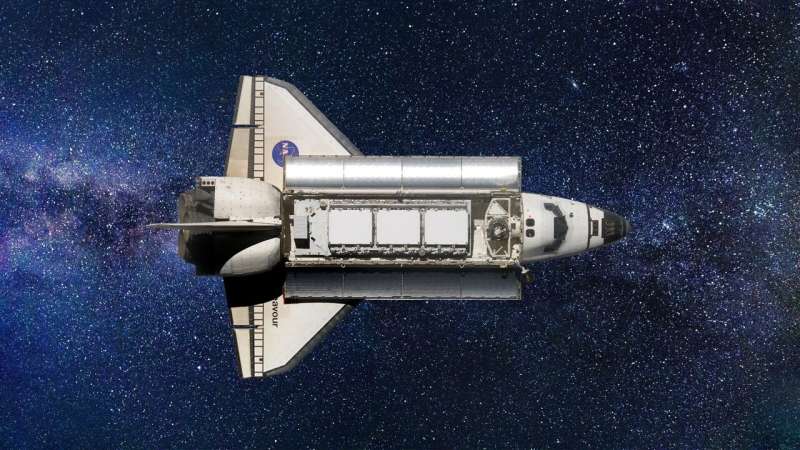This article has been reviewed according to Science X's editorial process and policies. Editors have highlighted the following attributes while ensuring the content's credibility:
fact-checked
reputable news agency
proofread
A successful liftoff: Space shuttle Endeavour's rockets are installed

In a delicate maneuver, crews successfully lifted into place giant rockets at the California Science Center, the first large components installed at the future home of the space shuttle Endeavour.
Donated by Northrop Grumman, the solid rocket motors are each the size of a Boeing 757 fuselage and weigh 104,000 pounds. They had to be carefully moved from a horizontal to vertical position by crane before being lowered into place in the new exhibit at the Samuel Oschin Air and Space Center.
One was installed Tuesday, the other Wednesday.
Crews were then able to place the 177 pins attaching each solid rocket motor to the base of the solid rocket booster, known as the aft skirt. Each pin is 1 inch in diameter and about 2 inches long.
"It felt great," California Science Center President Jeffrey Rudolph said of the successful installation. "We've got two solid rocket motors standing tall in the new building now."
Visitors to the museum can now see the top of the rockets from outside the construction site. At one point during the crane lift, the solid rocket motors could even be seen from the 110 Freeway.
This week's installations mark the latest milestone in the six-month mission to assemble the permanent exhibit for Endeavour, the last space shuttle orbiter ever built. When completed, it will be arranged in a full stack configuration as if it were ready for launch. It will be the only surviving U.S. orbiter displayed in this position.
Typically, during the era of space shuttle flights, this procedure would've been done at NASA's Vehicle Assembly Building at the Kennedy Space Center in Florida. There, the shuttle's full stack would've been assembled in one of the largest buildings by volume in the world, rising more than 50 stories and equipped with plenty of cranes and platforms from which to work.
At the California Science Center, crews had to develop unique techniques for the installation. This week, workers put together scaffolding along the aft skirts so they could get where they needed to insert the connecting pins.
If the aft skirt and solid rocket motors didn't align correctly, every pin could've taken some banging and pounding to insert, and the installation of each rocket could've taken all day and into the night.
Instead, Tuesday's work began around 9 a.m. and ended before 1 p.m. With one successful installation under their belts, workers were even quicker Wednesday—beginning at 8 a.m. and wrapping up by 10.
"The crew worked really well, did an excellent job and things came together effectively and quite quickly," Rudolph said.
The next step will be to build another 30 vertical feet of scaffolding to install external tank attach rings, which eventually will serve as a connection between the solid rocket motors and the giant orange external tank.
Later, even more scaffolding will rise to the top of the 116-foot solid rocket motors. That will help workers install the tips of the rockets, known as the forward assembly, which includes the nose cone and forward skirt.
The forward skirt is particularly important as it will be the primary weight-bearing connection between the solid rocket boosters and the external tank. It is likely to be installed in early December.
Each solid rocket motor makes up most of the length of the 149-foot solid rocket boosters. At liftoff, the white boosters were set underneath Endeavour's wings and produced more than 80% of the lift.
The most dramatic installations will take place after the winter holidays. The external tank will be lifted into place no sooner than early January.
The Endeavour orbiter will be installed no earlier than the last week of January. Cranes—the tallest of which will be about the height of Los Angeles City Hall—will raise Endeavour from its horizontal position to point vertically to the stars for its final display. The rest of the museum will then be built around it.
Once complete, the $400 million Samuel Oschin Air and Space Center will rise 20 stories tall. The California Science Center Foundation is still raising funds for the last $50 million needed for the project.
Since Endeavour's arrival at the center in 2012, the orbiter has been on display in the temporary Samuel Oschin Pavilion, essentially a warehouse, where it will be shown until Dec. 31. After that, it could be years before Endeavour will again be available for up-close viewing.
2023 Los Angeles Times. Distributed by Tribune Content Agency, LLC.





















